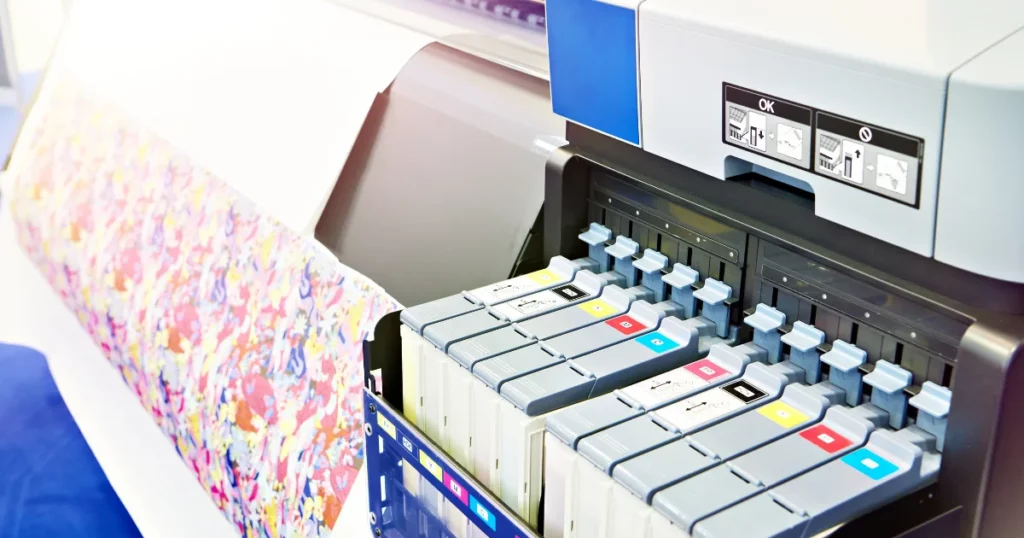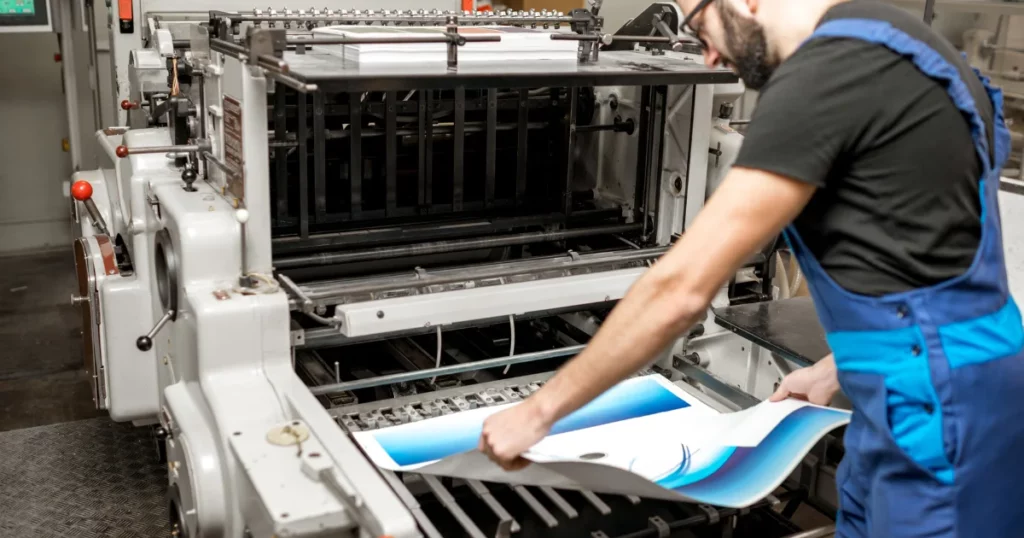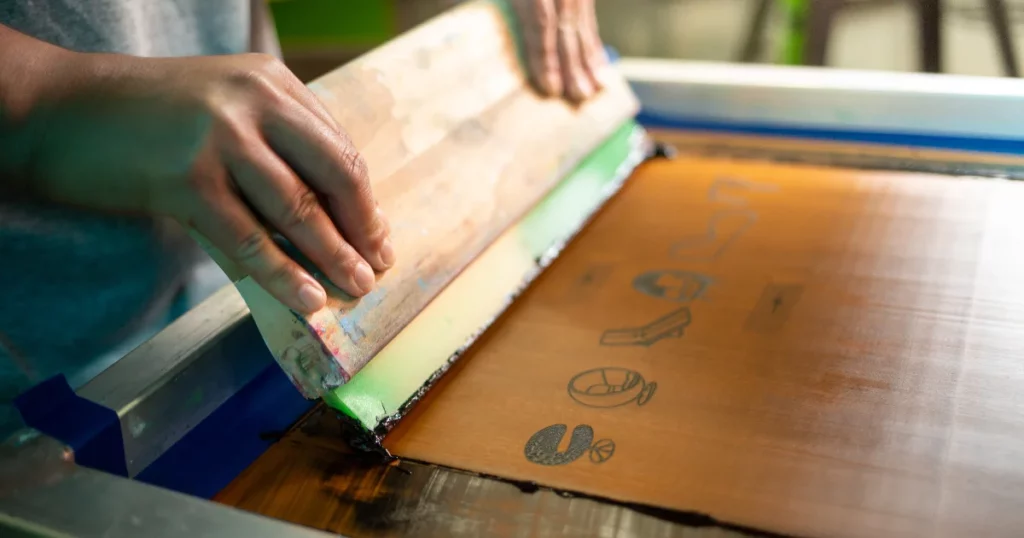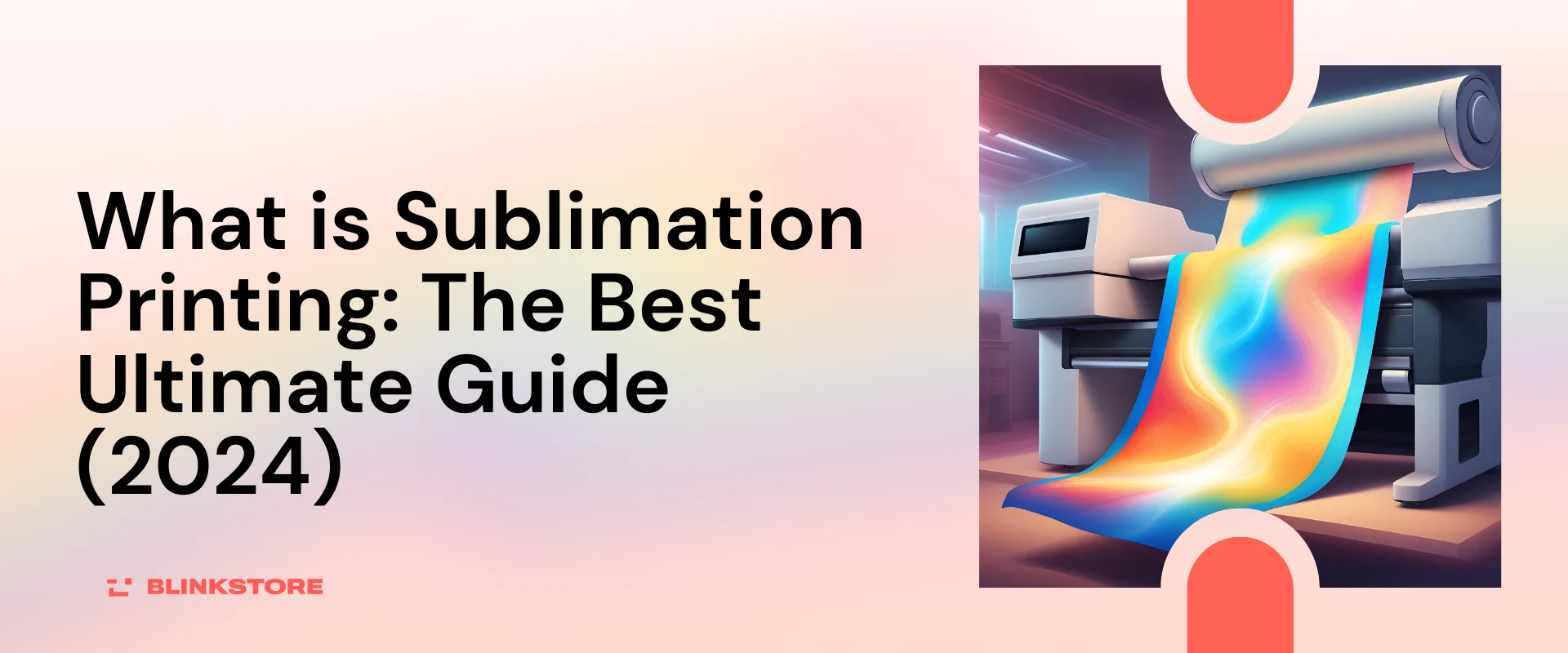The last few decades have seen the printing industry transform by leaps and bounds due to digital technology development, and novel processes One such process that has begun to gain popularity in recent years is sublimation printing. In this beginner’s guide, we’ll cover the key things about what is sublimation printing, What is the sublimation process? What are the products it is used on? And what are the main advantages of dye-sublimation over other printing methods?
Table of Contents
Introduction
Nowadays, sublimation printing is used to create personalized products at scale – from custom apparel like t-shirts, mugs, phone cases, awards, and trophies, and even decorative projects like aluminum prints or custom wood wall art. The possibilities are vast.
What is Sublimation Printing?
Sublimation printing, sometimes called dye-sublimation printing, is a digital printing technology that uses heat to infuse dye into manufactured products made of polymer-coated surfaces.
The process of sublimation printing uses specially engineered sublimation inks that turn into a gas when heated. The gaseous ink then permanently bonds with polymers like polyester, embedding itself beneath the surface. This allows the ink to essentially become part of the printed product rather than just sitting on top.
Unlike traditional printing methods, sublimation infuses color directly into the fabric or polymer coating on a product. The prints don’t simply coat the outside. This leads to professional, high-quality prints that won’t fade, chip, crack, or peel away from the product over time.
Sublimation printing requires three core components:
1. Sublimation Ink – This specialized ink turns to gas when heat is applied, allowing it to infuse into polymers. The ink determines the color quality.
2. Polymer-Coated Product – Whether a ceramic mug, polyester t-shirt, or aluminum board, sublimation only works on manufactured products with polymer coatings. Natural fabrics like cotton cannot be effectively sublimated.
3. Heat Press Machine – An industrial heat press that reaches over 380°F is required to activate the sublimation process and turn the prints into a gaseous dye.
When done right, the sublimation process results in vibrant, lasting print quality since the color essentially becomes part of the product.
Sublimation Printing Process

The sublimation process consists of two key steps:
- printing onto transfer paper, and
- heat transfer onto the final polymer-coated product.
To start, the desired graphics or images are printed out onto special transfer paper using a commercial sublimation printer loaded with sublimation ink. This allows the ink to be applied onto the paper just as any regular color printer would print an image.
Next, the printed transfer paper is firmly placed against a polymer-coated product like a ceramic mug, aluminum metal board, polyester fabric, etc.
The product is then inserted into a professional heat press machine that applies extreme heat and pressure – usually around 400°F at high pressure. This causes the ink on the transfer paper to turn gaseous.
The heat essentially activates the sublimation process, allowing the gaseous ink to permanently infuse into the polymer coating of the product you’re printing on. As the product cools, the ink solidifies and bonds at a molecular level inside the product.
When removed, the transfer paper is now blank while the product exhibits the permanent, vibrant print. Since the dye chemically reacts and embeds into polymers, sublimation only works on manufactured products with polyester polymer coatings or other synthetics.
Natural fabrics like cotton or leather, or products like paper or wood do not have polymer coatings so they cannot be effectively sublimated. Common sublimation materials include mugs, apparel, metals, ceramics, glass, and more – if they have a polyester or polymer coating.
The result of sublimation printing is professional, full-color graphics that won’t fade or deteriorate over time since the prints essentially become part of the product. It leads to exceptional customization and personalization for all kinds of consumer products and merchandise.
Benefits of Sublimation Printing

Sublimation sets itself apart from traditional printing methods by offering some exceptional benefits, especially when it comes to full-color graphics and merchandising consumer products. Some of the key advantages include:
1. Vibrant and True-to-Life Color Quality
Since the dye infuses directly into the coated surface at a molecular level, the prints exhibit stunningly vibrant colors and photorealistic detailing that brings designs to life. Sublimation offers a much larger color spectrum with up to 16 million colors.
2. Long-Lasting Durability
After being properly heat transferred, sublimation prints essentially become an integrated part of the product. This makes them extremely durable prints that do not fade, crack, peel, or deteriorate even after years of handling and washing.
3. Ideal for Apparel & Consumer Merchandise
The combination of exceptional print quality and long-term durability makes sublimation perfectly suited for printing branded apparel like t-shirts or sports jerseys as well as consumer merchandise like phone cases, mugs, mousepads, playing cards, and more. The entire product can be made to order.
Create customized designs with mockey.ai for the products you want to sell online including t-shirts, phone cases, tote bags, and more.
4. Cost-effective, Scalable Production
While there is some initial setup investment, sublimation becomes highly cost-effective when printing branded apparel or merchandise in bulk quantities thanks to minimal recurring costs per unit and the ability to print full-color graphics at scale. This makes it great for brands and online sellers alike.
Read more about: Best Print on Demand Tools for Your Business in 2024
Limitations of Sublimation Printing

1. Color Limitations
Sublimation is most effective on white or light-colored substrates, as the dye sublimation process does not produce opaque white ink. Therefore, designs on dark substrates may appear faded or lack vibrancy.
2. Material Restrictions
Sublimation is primarily suitable for synthetic fabrics or materials with a polyester coating. Natural fibers, such as cotton, are not receptive to sublimation inks, limiting the range of compatible substrates.
3. Surface Variability
An uneven or textured surface may result in incomplete transfer of the image and/or some disturbance on the design, given that sublimation requires a smooth flat level for optimal results.
4. Equipment and Skill Requirements
Sublimation requires specialized equipment, including sublimation printers and inks as well heat press which may cost more to start. Furthermore, to get the best results a certain degree of proficiency and accuracy in using equipment is needed as well as controlling the printing process itself.
Sublimation Printing Vs Screen Printing

Sublimation printing involves the use of heat to transfer dye onto materials such as fabric, plastic, or paper. This process requires special inks that, when heated, turn into a gas and permeate the material’s fibers, resulting in a highly durable and vibrant print. On the other hand, screen printing involves creating a stencil (screen) for each color, through which ink is then transferred onto the material using a squeegee.
1. Comparison based on ink types
Sublimation uses dye-based inks, while screen printing typically uses thicker, more opaque inks.
2. Pros and Cons Comparison
Sublimation Printing
| Pros | Cons |
| Ideal for full-color designs and intricate patterns | Limited to materials that are compatible with sublimation inks |
| Results in durable, long-lasting prints | Not suitable for dark-colored materials |
| Suitable for synthetic fabrics, promotional products, and personalized items |
Screen Printing
| Pros | Cons |
| Can produce vibrant prints on dark-colored materials | Not as suitable for detailed or multi-colored designs |
| Economical for large quantities | Labor-intensive for intricate designs with multiple colors |
| Versatile and suitable for various materials |
3. Types of Products Suitable for Each
Sublimation is well-suited for items such as custom apparel, personalized gifts, promotional products, and items with high-detail or full-color designs.
On the other hand, screen printing is often used for t-shirts, posters, banners, and other promotional materials, especially on dark-colored fabrics where sublimation printing may not be feasible.
4. Color Limitations
Screen printing is limited in its color capabilities, as each color requires a separate stencil and printing process. This can make it less suitable for designs with a wide range of colors or intricate details.
Unlike screen printing, sublimation printing does not require separate stencils or printing processes for each color, allowing for the seamless reproduction of complex and multi-colored designs.
5. When to Use Each Printing Method
Sublimation printing is best utilized for products requiring full-color, detailed, or photographic designs, especially on light or white materials.
On the other hand, screen printing is more appropriate for designs with fewer colors, especially on dark-colored materials, and for larger production runs where the cost per unit needs to be lower.
Are sublimation and heat transfer the same thing?
| Aspect | Sublimation Printing | Heat Transfer |
Process | Utilizes heat to sublimate inks and transfer them into the substrate | Involves transferring pre-printed designs from a carrier sheet onto the substrate |
Color Capabilities | Offers vibrant, full-color prints with intricate details | Can produce colorful designs but may have limitations based on the transfer method |
Suitable Materials | Primarily suitable for synthetic fabrics or materials with polyester coatings | Versatile, and suitable for a wide range of materials including textiles, ceramics, and metals |
Surface Compatibility | Requires a smooth and flat surface for optimal image transfer | Flexible in adapting to various surface textures and shapes |
Equipment Requirement | Specific sublimation printers, inks, and heat presses | Utilizes heat press or other transfer equipment, depending on the transfer method |
Durability | Provides long-lasting, wash-resistant prints | Can achieve durable prints with proper application and material selection |
What is Sublimation Printing Used for?

Sublimation printing is one of the most versatile techniques that are widely used on almost all kinds of products.
1. Apparel: Sublimation is the most popular for making vibrant designs on t-shirts, sports jerseys, and other fashion garments.
2. Housewares: Products like mugs, mousepads, and coasters can be customized through sublimation which gives high-quality prints that do not fade away easily.
3. Accessories: Sublimation is also ideal for personalizing accessories such as phone cases, keychains, and glass etching to produce detailed designs.
4. Wall Decor: This technique is used to produce wall décor that includes aluminum prints, canvas prints, and wood prints which are durable finishes.
5. Awards and Memorabilia: Sublimation can also be used to make custom-printed plates and sports gear, thus adding a touch of professionalism to awards and memorabilia.
Read more about: Types of T Shirt Printing: The Ultimate Guide (2024)
Conclusion
Sublimation printing is a technique that uses heat to transfer dye onto different surfaces, thereby producing bright and long-lasting prints. The process involves the conversion of ink from a solid to a gaseous state without passing through the liquid phase, thus suitable for printing high-quality, well-detailed, and full-color designs on different products. The increase in demand for sublimation is mostly due to its ability that makes it possible with the creation of long-lasting, detailed, and personalized products as a very crucial component within the customization segment of many industries as well as online markets in India.
FAQs – What is Sublimation Printing?
What is Sublimation Printing?
Sublimation printing is a method whereby dye materials are transferred by heat producing bright and long-lasting prints. It is frequently implemented in the manufacturing of individualized goods like garments, jewelry, and promotional items.
How Does Sublimation Printing Work?
Sublimation printing works by use of heat to transfer the dye materials into various substrates. The design is first printed on a special transfer paper and then transferred to the final product using heat pressure, dyes sublimate into the surface so colorful images become permanent.
What is Sublimation Printing on Fabric?
Sublimation printing on cloth involves the use of heat transfer to make dyes go into the fabric, which gives excellent designs that are bright and detailed. This technique is perfect for artificial textiles and presents such benefits as color fastness, and the ability to make complex patterns.
What is Sublimation Printing on T-Shirts?
Sublimation printing is in t-shirts and deals with the heat transfer process, which creates full-color designs that are semi-permanent. The dyes sublimate into the fabric creating a soft and breathable finish without sacrificing on brightness of the design.
What is Sublimation Printing on Mugs?
In sublimation printing on mugs, designs are printed onto coated ceramic items using heat and pressure. As a result of this process, one not only gets customized printed mugs but those that last long and are quality ones.
What is Dye Sublimation Printing?
Dye sublimation printing is a particular form of Sublimate Printing that utilizes dyes as its principal ink. This technique allows to development of gorgeous multi-colored patterns of superb wash fastness and resistance.
What is Sublimation Printing Design?
Sublimation printing design includes preparing the pieces of digital designs in employing desirable resolution and color profiles for subsequent sublimation printings. In the design phase, it is important to consider color vibrancy, detail clarity, and material compatibility.
Why Is Sublimation Printing Gaining Popularity in India’s Online Marketplaces?
In India, sublimation printing is rising as a result of the growing demand for individualized products in online marketplaces. This approach enables the production of items that are exclusive and individually suited to changing consumer trends in e-commerce, which is the customization of products.
Is Sublimation Printing Suitable for Personalized Gifts and Promotional Items?
Yes, sublimation printing is also ideal for producing customized presents and marketing material. It provides the flexibility to create complex designs, bright colors, and durable prints on different products which makes it a good option for personalization.
What Are the Benefits of Sublimation Printing in the Apparel Industry?
In the case of apparel, sublimation is quite beneficial and produces bright designs with high detailing ensuring that color remains intact after printing. It also works for fabricated fabrics and the garment customization is seamless.
How Does Sublimation Printing Contribute to the E-Commerce Industry in India?
sublimation printing plays a considerable role in the development of the e-commerce sector in India as it increases customization level and end-user experience. It allows online retailers to provide customizable products, so the customers looking for personalized and unique items can be attracted as well as retained.
What Factors Should I Consider When Choosing Sublimation Printing for My Products?
In the process of selecting sublimation printing for your products, you should take material compatibility, design complexity, and color into consideration. Further, factors like product application, order quantities, and customization should be considered to get better results.
Can Sublimation Printing Enhance the Branding and Marketing Efforts of Online Marketplaces in India?
Yes, value addition through sublimation printing can support the branding and marketing efforts of Indian online marketplaces by providing unique products that meet customer needs. It enables the design of branded giveaways and custom merchandise that further enhance a distinctive identity for brands as well as an effective marketing approach.
